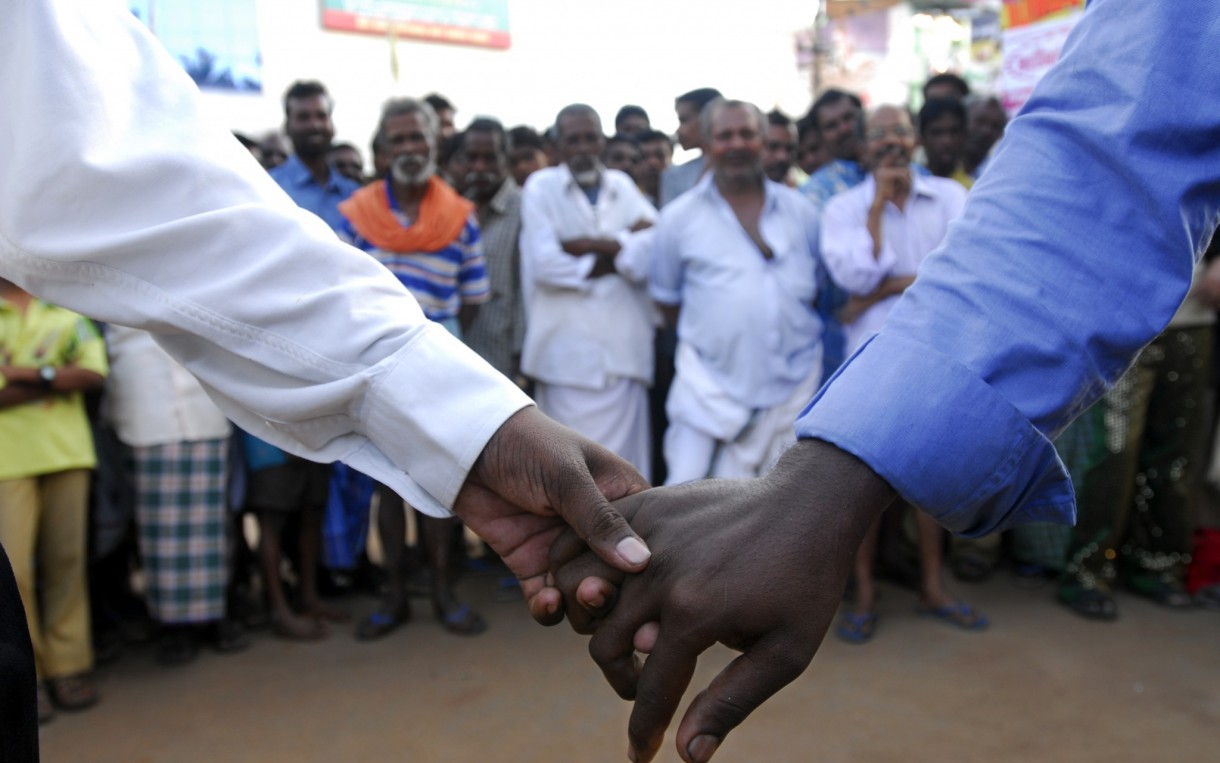Is consensus emerging on local leadership of humanitarian action?
 Between 2005 and 2008, Oxfam International and its partners developed a research program in the areas of Sri Lanka and India that were affected by the devastating 2004 Indian Ocean tsunami to improve the policies and practices of Oxfam and other aid agencies. The program involved around 40 individual studies on many topics including building local capacity. While each study produced its own findings, the overall message we received from the researchers and community members involved was that disaster-affected communities want a chance to guide their own relief and rehabilitation. Photo: Atul Loke / Panos for Oxfam America
Between 2005 and 2008, Oxfam International and its partners developed a research program in the areas of Sri Lanka and India that were affected by the devastating 2004 Indian Ocean tsunami to improve the policies and practices of Oxfam and other aid agencies. The program involved around 40 individual studies on many topics including building local capacity. While each study produced its own findings, the overall message we received from the researchers and community members involved was that disaster-affected communities want a chance to guide their own relief and rehabilitation. Photo: Atul Loke / Panos for Oxfam America
A number of national and international humanitarian agencies have pressed for greater attention to strengthening local capacity and working with local humanitarian actors on all phases of humanitarian action.
Marc Cohen is a Senior Researcher at Oxfam America.
This blog was originally posted on Oxfam’s From Poverty to Power site.
Over the past two years, a boatload of reports and studies has pointed to the need to shift to greater local leadership of disaster prevention, preparedness, and response. In part this is driven by mounting humanitarian needs and the growing gap between those needs and the aid actually provided. There is also a related concern with the effectiveness of humanitarian action in an era of scarce resources. And for some, it is a matter of rights and justice, embodied in the principle of subsidiarity.
A number of national and international humanitarian agencies have pressed for greater attention to strengthening local capacity and working with local humanitarian actors on all phases of humanitarian action. This has led to such reports as the ‘Missed Opportunities’ series on the importance of humanitarian partnerships with local actors, and ‘Funding at the Sharp End’, looking at the resources that international humanitarian NGOs transfer to local partners. Further, the Charter for Change has been developed – this seeks tangible commitments from INGOs on localisation, to be achieved by 2018.
For its part, Oxfam has recently argued that ‘shifting the centre of preparedness and response to the national and local level puts responsibility, decision making, and power where it should be: in the hands of the people affected most by crisis’. Of course, we look at this through the lens of effective states and active citizens, in keeping with our rights-based approach and the approach of this blog. We’ve tried to put our money where our mouth is on this issue. Over the past decade, we’ve received multiple grants from the Bill & Melinda Gates Foundation for emergency response and disaster risk reduction efforts, including capacity-strengthening of partners, in Central America. One of those partners is the Concertación Regional de Gestión de Riesgos (CRGR), a four-country regional organization aimed at increasing the capacity of vulnerable communities to prepare for and respond to disasters. In a demonstration of our commitment and that of our partners to effective capacity strengthening, in 2012, the Gates Foundation awarded $1.6 million directly to CRGR.
Now the International Federation of Red Cross and Red Crescent Societies (IFRC) – the world’s largest humanitarian network – has joined this debate. Through its 189 National Societies and the efforts of its 17 million volunteers who work through local chapters, the Federation reaches 150 million people worldwide. This year, IFRC is devoting its widely read World Disasters Report to the topic of local humanitarian actors, whom it characterises as ‘the key to humanitarian effectiveness.’
Federation Secretary-General Elhadj As Sy emphasises in his foreword to the report that calling for greater international recognition of, and support for local humanitarian actors does not mean that there is no longer a role for international actors: ‘ The international community still has a very important role to play, but a better balance needs to be struck. International actors can provide specialized resources and technical expertise, brought with humility, trust and respect, and with a true commitment to building local capacity.’
Likewise, Dr Jemilah Mahmood, the Head of the Secretariat of the World Humanitarian Summit—which will take place in May 2016 in Istanbul—has noted that one of the strongest calls from the global consultations that have taken place in the run-up to the Summit has been for ‘countries, communities and local organizations, including the private sector, to manage natural disaster risk and response by themselves, building on their own knowledge and expertise’.
So, do we have consensus that localisation should top the humanitarian effectiveness agenda? Hardly.
In mid-September at the International Conference: A Quest for Humanitarian Effectiveness?, held in Manchester, UK, there was a lively debate on localisation. Proponents argued that local leadership is faster, cheaper, and helps more people than big, clunky, internationally-led responses. They pointed to the example of Bangladesh, which experiences far fewer deaths when cyclones hit thanks to substantial investments in early warning, better storm shelters, and disaster management bodies from the community to the national level. Critics wondered whether local actors can deliver health, water, and sanitation services needed in large-scale emergencies, and how local leadership works in situations of armed conflict when the government is implicated in the violence and has suppressed civil society.
This debate will go on, well beyond the Summit in Istanbul. But it is heartening that a big international humanitarian actor such as the IFRC has joined in the fray on the side of strengthening local actors so that they can take the lead.